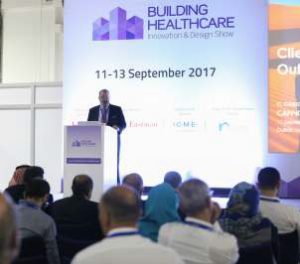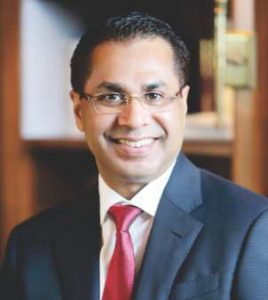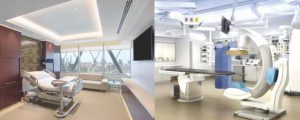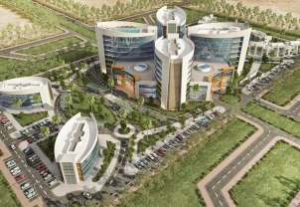With the UAE boasting the strongest growth rate in healthcare sector, billions of dollars are being poured into new projects in MENA to build top facilities for patients both from within and outside the region
To ensure that the healthcare infrastructure is well in place and according to the guidelines, the infrastructure should convey a positive message to its patients, visitors, volunteers and staffs about what the facility and medical care is being provided there. An ideal message should be welcoming, caring, comforting with compassion and commitment to patient well-being and safety, healthcare experts highlight.
The UAE healthcare market is reportedly expected to be valued at $19.5 billion by 2020, achieving an annual average growth of 12.7 per cent, which is the strongest growth rate in the GCC region, industry statistics highlight. Just some of the measures being taken to drive growth in the sector by the government include encouraging private sector participation to build hospitals and clinics and introducing mandatory health insurance for everyone. The PPP model will grow increasingly popular in the years to come as private sector investment will be encouraged.
some of the measures being taken to drive growth in the sector by the government include encouraging private sector participation to build hospitals and clinics and introducing mandatory health insurance for everyone. The PPP model will grow increasingly popular in the years to come as private sector investment will be encouraged.
MediWorld ME recently met with Faizal E. Kottikollon, Founder, Chairman and Chief Executive Officer, KEF Holdings Limited to discuss what an ideal healthcare structure looks like in the UAE and beyond.
Ideal healthcare infrastructure
Over the years, healthcare projects have been designed and built primary on immediate and at the best near future needs. According to National Institute of Building Sciences, an ideal healthcare infrastructure has a life span of 50 – 100 years or more. The forces that influence the need for flexibility are numerous and ever-evolving.
 “Investors are always looking to reduce costs and shorten construction schedules without compromising high-quality design and finishes. The move toward more standardized environments and systematic approaches to care delivery makes offsite manufacturing, where 90 per cent of the hospital is manufactured in a controlled factory environment and assembled onsite, the ideal method for building hospital infrastructure. This reduces construction time by up to 50 percent which allows for significant return on investment for the project.
“Investors are always looking to reduce costs and shorten construction schedules without compromising high-quality design and finishes. The move toward more standardized environments and systematic approaches to care delivery makes offsite manufacturing, where 90 per cent of the hospital is manufactured in a controlled factory environment and assembled onsite, the ideal method for building hospital infrastructure. This reduces construction time by up to 50 percent which allows for significant return on investment for the project.
In the UAE, this approach has not been adopted so far in totality in the healthcare industry. At KEF, we see a huge opportunity in this respect, which is why our focus is set on bringing turnkey, design and build, infrastructure solutions to the Emirates,” Mr Kottikollon explained.
Physical environment
Many construction experts have identified that physical environment has a significant impact on safety and human performance, the tools used, and the environment in which they live and work is basic to any study of the design a healthcare facility and its effect on the performance of the nurses and other caregivers who interface with the facility and its fixed (e.g., oxygen and suctioning ports on the wall of a patient room) and moveable (e.g., a patient bed) equipment and technology.
The design of a facility with its fixed and moveable components can have a significant impact on human performance, especially on the health and safety of employees, patients and families. In a review of more than 600 articles, researchers found that there was a link between the physical environment (i.e., single-bed or multiple-bed patient rooms) and patient (e.g., fewer adverse events and better health care quality) and staff outcomes (e.g., reduced stress and fatigue and increased effectiveness in delivering care).
rooms) and patient (e.g., fewer adverse events and better health care quality) and staff outcomes (e.g., reduced stress and fatigue and increased effectiveness in delivering care).
Efforts to improve patient and staff outcomes can target latent conditions for clinicians by using evidence-based designs to decrease distractions, standardize locations of equipment and supplies, and ensure adequate space for documentation and work areas. The research done by ‘Reason and Leape’ describes the value of practices based on principles designed to compensate for human cognitive failings.
Operation and management
Growing evidence advocates the fact that physical environment impacts patient stress, patient and staff safety, staff effectiveness, patient satisfaction and quality of care provided in hospitals. Based on such research findings, KEF takes informed design decisions on the built environment of any healthcare facility, through its infrastructure arm, KEF Infra.
“On the other hand, our Healthcare division, KEF Health, advocates evidence-based clinical care to reduce variability, and consistently improve efficiencies of outcomes at a lower cost through designing optimal, evidence-based care paths. In developed markets, offsite and modular construction is fast replacing one-off design & conventional healthcare construction methodologies. Recent years have seen the emergence of large-scale  manufacturing, installation and assembly of high quality, affordable hospital units off-site. With modular healthcare construction, KEF expects to turnaround the economies in the healthcare sector, enabling a system of rapid delivery of affordable healthcare facilities,” the CEO noted.
manufacturing, installation and assembly of high quality, affordable hospital units off-site. With modular healthcare construction, KEF expects to turnaround the economies in the healthcare sector, enabling a system of rapid delivery of affordable healthcare facilities,” the CEO noted.
KEF Health’s philosophy extend far beyond in terms of efficient and effective operation, maintenance and evaluation of the healthcare system.
Efficiency and sustainability
In an ideal situation, the sustainability process should start right from the design stage, and continue through each step of development of the hospital.
Mr. Kottikollon continued, “In the case of offsite manufacturing of hospitals, the time savings delivered in developing a healthcare facility results in significantly higher ROI for the investor. Moreover, the manufacturing processes, covering each element from the façade to furniture within the hospital, are undertaken in a controlled environment, where the margin of error and wastage is almost negligible.
Once the facility is handed over, the infrastructure which builds on advanced BIM technology, can be monitored and managed – allowing even the slightest anomalies to be detected and any consequent errors to be avoided. In the long-run, healthcare facilities that have a foundation rooted in technology will go a long way in bringing about greater efficiencies in the patient experience.”
Considering other factors
With human factors in mind, there are several other aspects of the building environment that should be considered. In a review of the literature by Henriksen and Colleagues, the following design elements were identified as critical in ensuring patient safety and quality care, based on the six quality aims of the Institute of Medicine’s report, Crossing the Quality Chasm: A New Health System for the 21st Century includes patient centeredness, safety, effectiveness, efficiency & equity.
There have been five other significant reviews of the literature relating to the physical environment and patient outcomes. Nelson and Colleagues identified the need to reduce noise pollution and enhance factors that can shorten a patient’s length of stay (e.g., natural lighting, care in new/remodeled units and access to music and views of nature); according to their study, patients can benefit from the skilful utilization of music and artwork.
Ulrich and Colleagues found research that demonstrated that the design of a hospital can significantly improve patient safety by decreasing health care associated infections and medical errors. They also found that facility design can have a direct impact on patient and staff satisfaction, a patient’s stress experience, and organization performance metrics. Three other reviews found that hospital design, particularly when single-bed rooms are employed, can enhance patient safety and create environments that are healthier for patients, families and staff by preventing injury from falls, infections and medical errors; minimizing environmental stressors associated with noise and inefficient room and unit layout; and using nature, colour, light and sound to control potential stressors.
Billions in investments
On a related note, healthcare projects worth $55.2 billion are currently in the pipeline in the Middle East and North Africa (MENA) region, according to latest industry estimates. A total of 37 mega hospital projects worth about $28.2 billion are already underway in the Gulf region, and these are expected to add 22,500 hospital beds to existing capacity according to Alpen Capital Healthcare Report. The rest of the year is expected to be even more robust for the healthcare projects market, with major projects being undertaken throughout the region, the report said.
Healthcare spending in MENA is expected to grow to $150 billion in 2020. In the GCC countries, it will account for about $70 billion of this spending with a compounded annual growth rate of over 12 per cent, one of the highest for any part of the world, according to global property consultant JLL.
The world spending on healthcare is expected to increase from $8 trillion in 2013 to $18 trillion in 2040, according to industry estimates. The demand for quality healthcare facilities in the MENA region has been growing dramatically.
Population growth is the key driving force that boost the demand for healthcare. The population of the region has increased by 1.9 per cent per annum, to reach approximately 470 million, which is well above the global average of 1.1 per cent. An ageing population acts as a further contributor.
Other factors include a need to increase healthcare spend as a percentage of GDP. The increasing prevalence of lifestyle diseases are expected to continue to drive the demand for healthcare services across the region. The development of the Health Insurance Sector, including governments making health insurance mandatory across the GCC by 2020 will act as a significant driver of further private sector investment.
Regional initiatives
Regional governments recognizing the need for this in the long term development of their countries have supported and invested in healthcare. Dubai in particular has been ahead of chart when it comes to setting up healthcare infrastructure. For e.g. Dubai Healthcare City the healthcare free zone was launched 15 years ago. There has also been a significant investment by the private sector in healthcare, recognizing the long term opportunity of this real estate asset class.
Another area that needs to be addressed as the healthcare industry grows a lot further is the need to have world class medical universities which would provide the human capital needed for regional growth to be sustained. The UAE is ranked 27 in world health systems as per the World Health Organization (WHO).
The UAE healthcare sector has displayed extraordinary growth and significant progress. The Health Authority Abu Dhabi (HAAD), Abu Dhabi Health Services Company (SEHA) and Dubai Health Authority (DHA) have developed a highly efficient health service system that includes sophisticated physical infrastructure and cutting edge IT service.
According to Alpen, the healthcare market in the UAE is projected at $19.5 billion in 2020, indicating an annual average growth of 12.7 per cent from 2015. The outpatient and inpatient markets are projected to reach $12.1 billion and $7.5 billion, respectively, in 2020. The country is likely to see a nearly 3 per cent annual increase in the number of hospital beds required, presenting a demand of more than 13,800 beds by 2020.
In the UAE, some of the high-profile projects coming up include Al Ain Hospital in Al Ain, Burjeel Medical City in Abu Dhabi, Gulf Medical University Hospital in Ajman, Mediclinic Parview Hospital and King’s College Hospital (KCH) in Dubai.
Projects in Saudi Arabia
The Saudi Arabian healthcare market is forecasted to reach $27.4 billion in 2020, registering a CAGR of 11 per cent from 2015. The outpatient and inpatient markets are expected at $15.2 billion and $12.2 billion respectively in 2020. From less than 70,000 in 2015, the number of beds required in the kingdom is likely to cross 76,500 in 2020.
Some of the latest hospital building projects in Saudi Arabia are King Abdullah Bin Abdulaziz, Project for Development of Security Forces Medical Complexes; King Khaled Medical City in Dammam; King Faisal Medical Cit in Asir; Mouwasat Hospital in Al Khobar and Amal Mental Health Hospital in Taif.
Saudi government is keen on developing and modernizing the healthcare industry on priority basis. It is encouraging the involvement of more private sector to improve the quality of healthcare. The Saudi health ministry has commissioned few projects to bridge the gap in healthcare infrastructure. The Kingdom offers attractive opportunities to foreigners to invest in the country’s healthcare facilities.
“The healthcare sector offers the ability for real estate investors to participate in a growing market backed by the government, where long-term leases can be structured to major regional and international healthcare providers,” said Craig Plumb, head of research, MENA – JLL.
The MENA region has undoubtedly made significant strides in a relatively short period of time in the healthcare sector and with the continued focus in addressing the challenges by regional governments, the outlook for this sector continues to look upward.
















